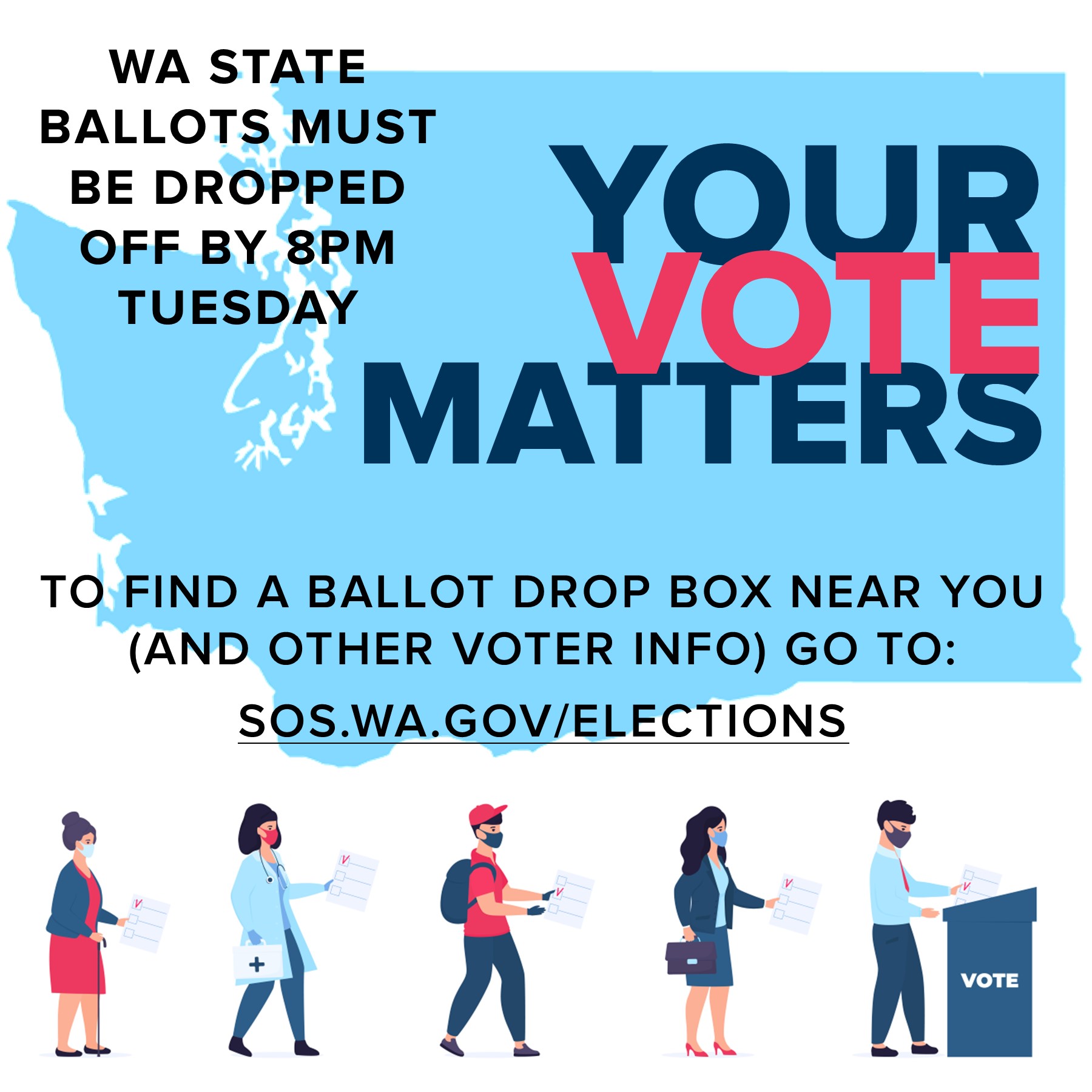Last week I had the pleasure of attending Matthew Gardner’s 2021 Economic Forecast. Matthew is Windermere’s Chief Economist and coveted expert in our region often called upon by the local and national media for his insights on the economy and housing. Windermere has relied upon his forecasts and advice for over 15 years, and we were lucky to appoint him Chief Economist in 2015. He has been a huge asset to Windermere brokers who utilize his knowledge to help educate their clients in order for them to be empowered to make strong decisions.
Here are Matthew’s Top 10 Things to Look for in 2021:
#1 THE ECONOMY. Matthew expects the economy to continue to recover from the impact caused by the pandemic. He notes that we have already started to see jobs return, but with the vaccine starting to be administered he predicts additional gains in jobs over the second half of the year as businesses start to re-open at full capacity. In addition to jobs, he shared that many Americans have not been spending money like they typically do and have excess cash to spend, leaving many folks eager to travel, make big purchases, or just go out to dinner. The combination of re-opening and more disposable spending will help re-build industries hit hard like entertainment, hospitality, and dining. Supporting small businesses within your community was also something he encouraged consumers to engage with as that will trickle back into the recovery of the overall economy. He expects an increase in spending and additional job creation to boost the economy as we head into spring and summer.
#2 SURGE TO THE ‘BURBS. In 2020 we saw a large number of buyers moving to the suburbs due to the work from home (WFH) phenomenon and affordability. Living in urban areas is more expensive, and with many companies planning on continuing to let their employees WFH indefinitely or half-time moving forward, this has reduced the importance of commute time on a buyer’s wish list. This has also afforded buyers larger homes and yards in comparison to the more compact urban options. Do note however, that Seattle is not losing population, as the net in-migration figure for Seattle in 2020 was up 3.3%.
#3 PREFERRED HOME FEATURES. What buyers are looking for in a home is changing. Open-concept floorplans used to be all the rage, but now buyers are looking for separate spaces where an at-home office or Zoom space can be incorporated. Outdoor living areas are also coveted due to the option for year-round entertaining and/or exercise/home gym space. Rural homes with high-speed internet are coming at a premium as these properties create room to roam and the option to WFH. Not all rural areas have the infrastructure in place to support the technology needed to WFH, so the areas that do are in demand.
#4 INTEREST RATES. In 2020, we broke the all-time low for interest rates 16 times! We are currently under 3% and down an entire point from the previous year. This has fueled demand in all segments of the market, particularly first-time homebuyers, luxury buyers, retirees downsizing, and move-up buyers. Note that a one-point drop in interest rate gives a buyer 10% more buying power, which is helping off-set the expense of price growth. While Matthew anticipates rates rising in 2021, he expects them to settle around 3.1%. With the long-term average at 7.9%, a bump up above 3% is still something to celebrate and will continue to be the gas in the tank of buyer demand.
#5 MORTGAGE FORBEARANCE. In the spring of 2020, the banks were quick to offer the option of mortgage forbearance in response to the job losses created by the pandemic. Many homeowners that needed to, took advantage of this option. The good news is that since May there has been a 43% reduction in participants in the program. Currently, there are 2.7M people in the program, many of which are returning to work and will be able to continue with their mortgage payments. For those that will not be able to afford the monthly payments, the option to sell after double-digit year-over-year price appreciation in markets such as WA, CO, OR, MT, and ID will provide a financial benefit. Matthew disagrees with the naysayers that think we are sitting on the brink of a wave of foreclosures in our region as equity levels are in favor of a homeowner selling vs. giving their home back to the bank. Buyer demand is also at an all-time high ensuring a plentiful homebuyer audience.
#6 HOME PRICES & SALES. Strong buyer demand will continue due to low interest rates and lifestyle moves influenced by the option to WFH and Baby Boomers retiring. Matthew believes we will have an increase in closed sales in 2021 and that we will continue to have price appreciation. Bear in mind that we are coming off above-average year-over-year price appreciation in 2020 (up 12% in Snohomish County & 7% in King County), and he expects price growth to temper in 2021 year-over-year which will help with affordability and rate increases.
#7 LUXURY HOME MARKET. 2020 was an amazing year for the luxury home market, with closed sales over $1M in King and Snohomish Counties up 30% and over $2M up 28%. There was a brief stall in the spring when jumbo loan rates surged and were in some cases unavailable at some banks. By May, jumbo loans found their place in the market, and homebuyers in the upper price points were able to enjoy the historically low interest rates as well. Matthew sees this continuing in 2021 along with more foreign buyers coming to the market with international travel opening back up in the second half of the year.
#8 ZONING. Matthew sees affordability as the biggest challenge in our market and zoning changes are the most efficient way to solve it. He expects legislators to have more discussions about adjusting zoning policies to create more affordable housing. He does not expect this to happen overnight or even in 2021, but for the stage to start to be set to make progress in this arena.
#9 APARTMENT RENTAL MARKET. The pandemic has been rough on the rental market, especially apartment rentals in big cities such as Seattle. The WFH option and a newfound aversion to shared living spaces have driven increases in vacancy rates. This has caused rental rates to decrease, and with an anticipated bumper crop of new apartments set to come to market in 2021 this segment of the market will take some time to recover due to supply and demand. Single-family rentals have fared much better than apartments. We expect the eviction moratorium to be lifted in tandem with increased vaccination rates and the rebound of the job market.
#10 ADAPTIVE REUSE. While the expense to convert apartments to condominiums is cost-prohibitive, he sees some opportunity to convert some hotel spaces to residential living. This goes in-line with creating more affordable housing and could be a positive economic option for motel or inn owners that have suffered during the pandemic. Other adaptive reuse options due to the surge in online commerce would be shopping malls converting to mixed-use (commercial with residential) space, and strip malls being bought out by developers for residential units.
Overall, Matthew’s take on the economy as we head into 2021 is hopeful and on the housing market extremely positive. If you would like the recording of his forecast or the Power Point slides in PDF format to review the data yourself, please reach out. It is always my goal to help keep my clients informed and empower strong decisions.
Top 10 Things to Look for in 2021

South King County Quarterly Market Trends – Q4 2020
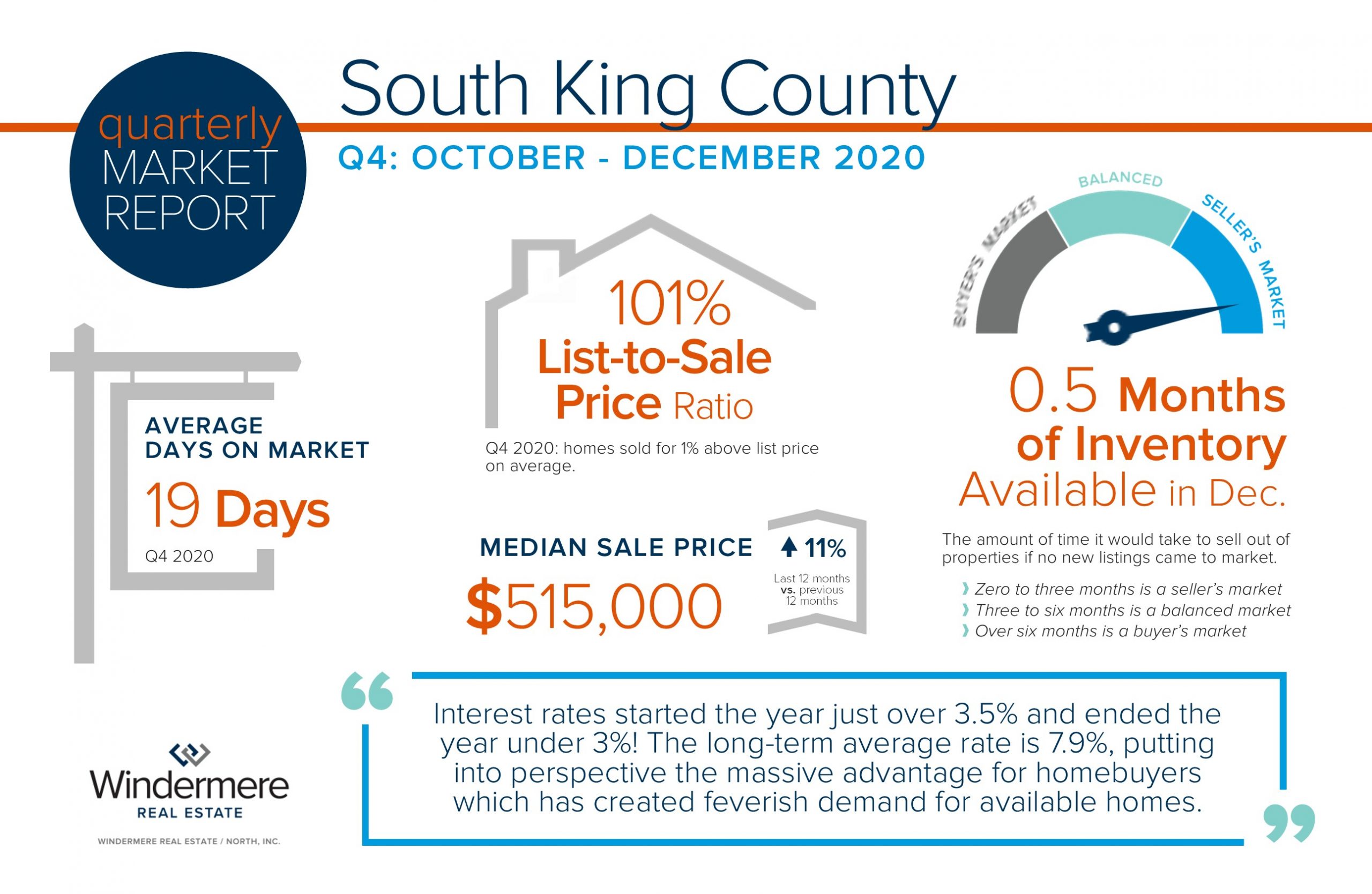
The 2020 real estate market was a bright spot in the economy and the fourth quarter finished strong, with the median price up 11% complete year-over-year. Interest rates started the year just over 3.5% and ended the year under 3%! The long-term average rate is 7.9%, putting into perspective the massive advantage for homebuyers which has created feverish demand for available homes. Even though new listings remained even year-over-year, low interest rates helped drive a 3% increase in closed sales in 2020.
Pandemic-driven moves were spurred by folks working from home, taking early retirement, and in some cases responding to job loss. Remote working eliminated the need to have a home close to work which encouraged people to flee to the suburbs. Eliminating the commute and the desire for larger spaces with outdoor enjoyment quickly moved to the top of peoples’ wish lists. The last 8 years of positive price growth has led to formidable seller equity, enabling early retirement for some and/or the opportunity to liquidate and recover from the negative effects in some employment industries.
We expect rates to stay low in 2021 and with many Millennials coming of age there will continue to be large amounts of homebuyers eagerly waiting for fresh inventory. Ending the year at 0.5 months of inventory is essentially ground zero for selection, putting home sellers in the driver’s seat for now. I will continue to keep you updated throughout 2021 as we navigate these unique times. It is my goal to help keep my clients informed and empower strong decisions; please reach out if I can help.
North Snohomish County Quarterly Market Trends – Q4 2020
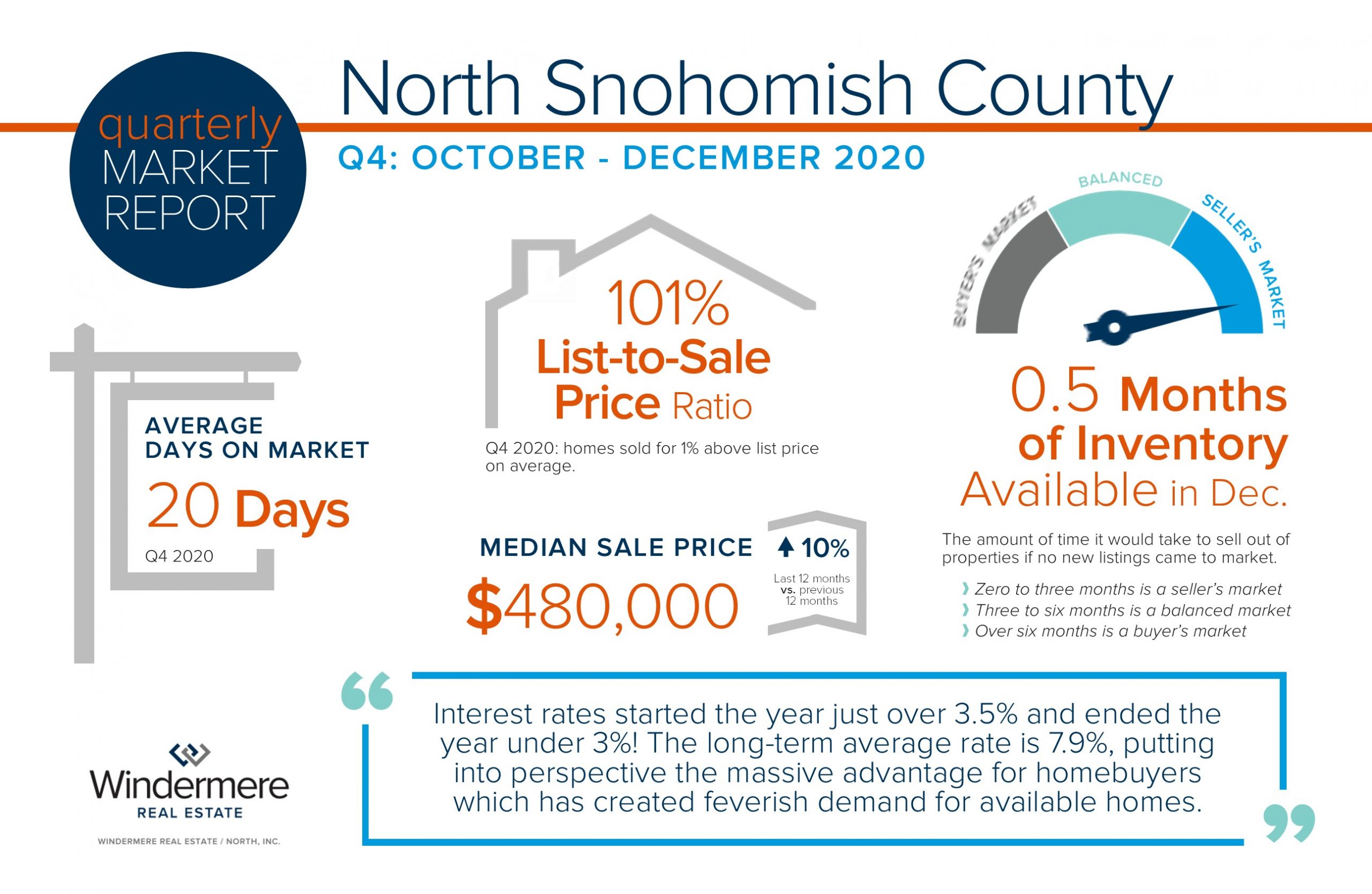
The 2020 real estate market was a bright spot in the economy and the fourth quarter finished strong, with the median price up 10% complete year-over-year. Interest rates started the year just over 3.5% and ended the year under 3%! The long-term average rate is 7.9%, putting into perspective the massive advantage for homebuyers which has created feverish demand for available homes. Even though new listings remained even year-over-year, low interest rates helped drive an 8% increase in closed sales in 2020.
Pandemic-driven moves were spurred by folks working from home, taking early retirement, and in some cases responding to job loss. Remote working eliminated the need to have a home close to work which encouraged people to flee to the suburbs. Eliminating the commute and the desire for larger spaces with outdoor enjoyment quickly moved to the top of peoples’ wish lists. The last 8 years of positive price growth has led to formidable seller equity, enabling early retirement for some and/or the opportunity to liquidate and recover from the negative effects in some employment industries.
We expect rates to stay low in 2021 and with many Millennials coming of age there will continue to be large amounts of homebuyers eagerly waiting for fresh inventory. Ending the year at 0.5 months of inventory is essentially ground zero for selection, putting home sellers in the driver’s seat for now. I will continue to keep you updated throughout 2021 as we navigate these unique times. It is my goal to help keep my clients informed and empower strong decisions; please reach out if I can help.
Seattle Metro Quarterly Market Trends – Q4 2020
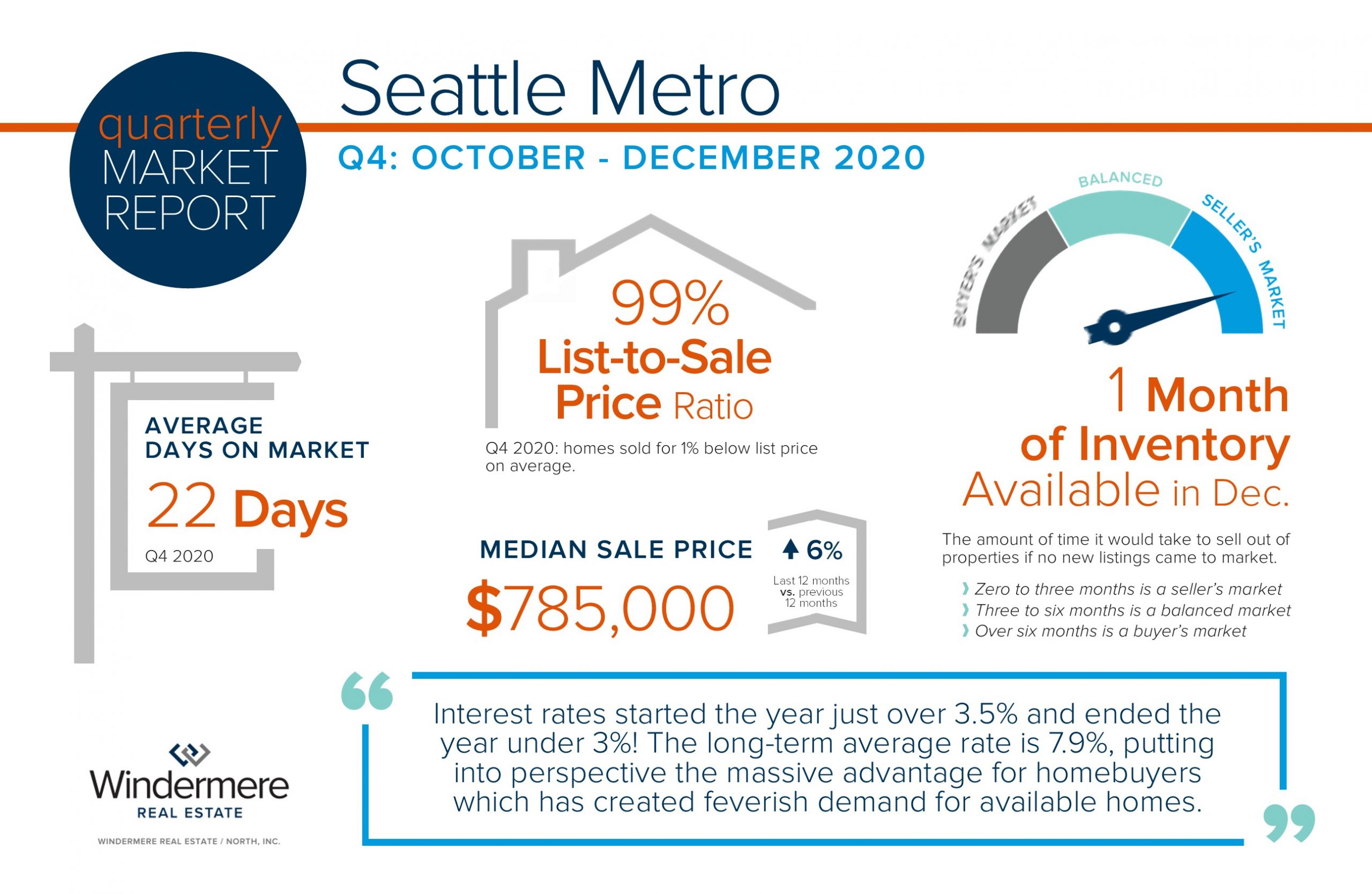
The 2020 real estate market was a bright spot in the economy and the fourth quarter finished strong, with the median price up 6% complete year-over-year. Interest rates started the year just over 3.5% and ended the year under 3%! The long-term average rate is 7.9%, putting into perspective the massive advantage for homebuyers which has created feverish demand for available homes. Even though new listings were up 8% in 2020, low interest rates helped drive a 12% increase in closed sales.
Pandemic-driven moves were spurred by folks working from home, taking early retirement, and in some cases responding to job loss. Remote working eliminated the need to have a home close to work which encouraged people to flee to the suburbs. Eliminating the commute and the desire for larger spaces with outdoor enjoyment quickly moved to the top of peoples’ wish lists. The last 8 years of positive price growth has led to formidable seller equity, enabling early retirement for some and/or the opportunity to liquidate and recover from the negative effects in some employment industries.
We expect rates to stay low in 2021 and with many Millennials coming of age there will continue to be large amounts of homebuyers eagerly waiting for fresh inventory. Ending the year at one month of inventory is essentially ground zero for selection, putting home sellers in the driver’s seat for now. I will continue to keep you updated throughout 2021 as we navigate these unique times. It is my goal to help keep my clients informed and empower strong decisions; please reach out if I can help.
Eastside Quarterly Market Trends – Q4 2020
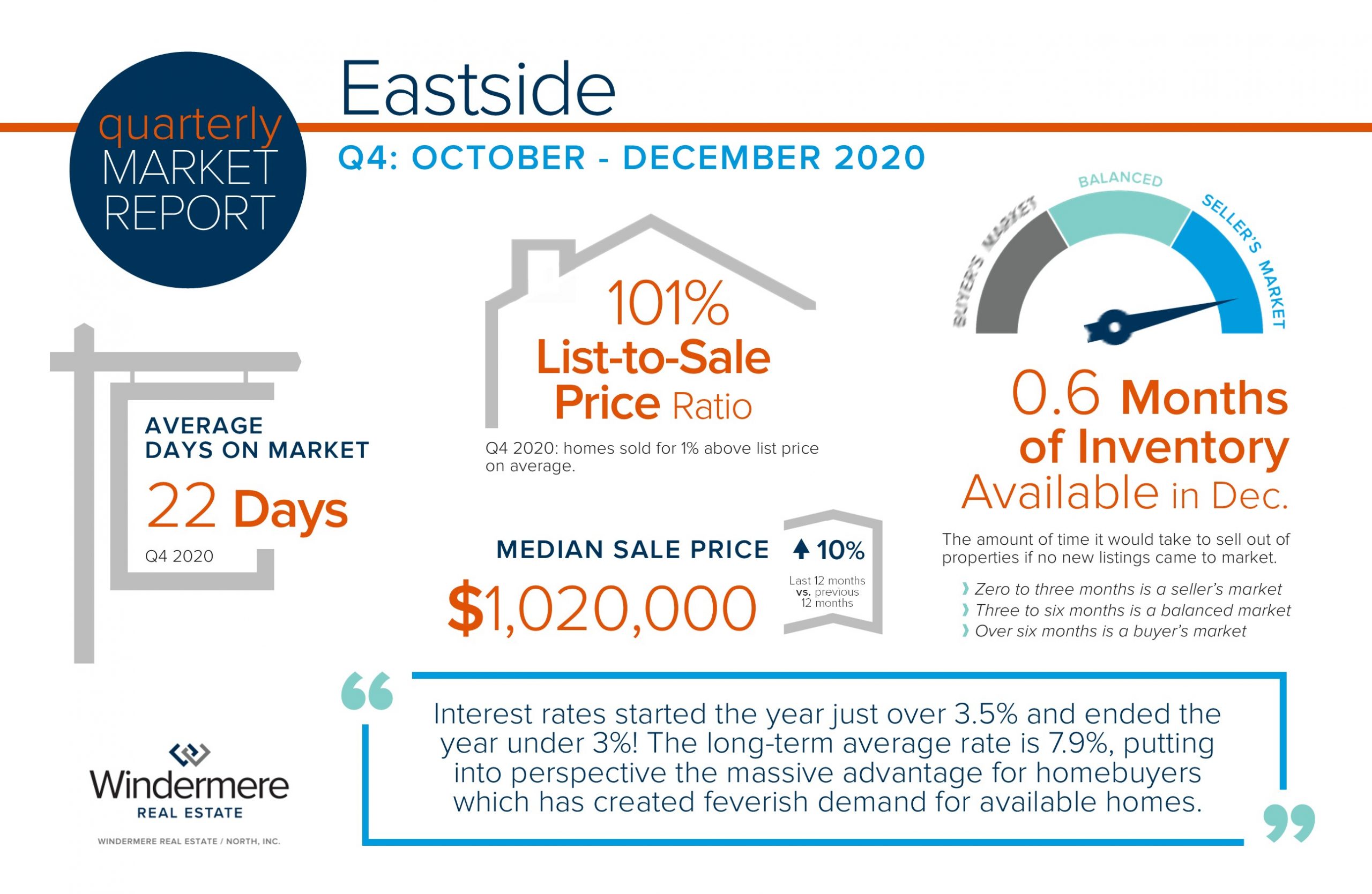
The 2020 real estate market was a bright spot in the economy and the fourth quarter finished strong, with the median price up 10% complete year-over-year. Interest rates started the year just over 3.5% and ended the year under 3%! The long-term average rate is 7.9%, putting into perspective the massive advantage for homebuyers which has created feverish demand for available homes. Even though new listings were down by 6% in 2020, low interest rates helped drive a 3% increase in closed sales.
Pandemic-driven moves were spurred by folks working from home, taking early retirement, and in some cases responding to job loss. Remote working eliminated the need to have a home close to work which encouraged people to flee to the suburbs. Eliminating the commute and the desire for larger spaces with outdoor enjoyment quickly moved to the top of peoples’ wish lists. The last 8 years of positive price growth has led to formidable seller equity, enabling early retirement for some and/or the opportunity to liquidate and recover from the negative effects in some employment industries.
We expect rates to stay low in 2021 and with many Millennials coming of age there will continue to be large amounts of homebuyers eagerly waiting for fresh inventory. Ending the year at 0.6 months of inventory is essentially ground zero for selection, putting home sellers in the driver’s seat for now. I will continue to keep you updated throughout 2021 as we navigate these unique times. It is my goal to help keep my clients informed and empower strong decisions; please reach out if I can help.
North King County Quarterly Market Trends – Q4 2020
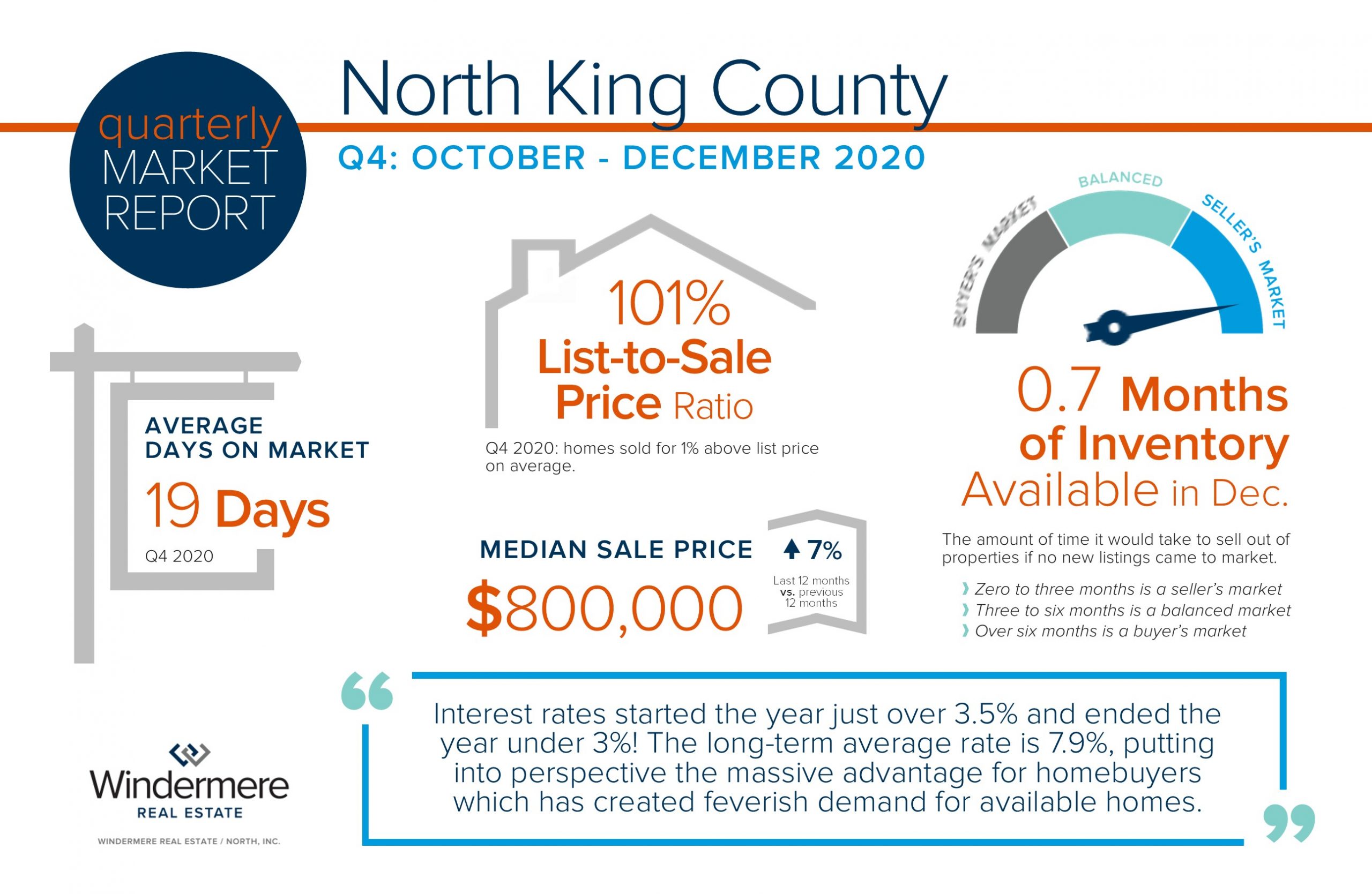
The 2020 real estate market was a bright spot in the economy and the fourth quarter finished strong, with the median price up 7% complete year-over-year. Interest rates started the year just over 3.5% and ended the year under 3%! The long-term average rate is 7.9%, putting into perspective the massive advantage for homebuyers which has created feverish demand for available homes. Even though new listings remained even year-over-year, low interest rates helped drive a 7% increase in closed sales in 2020.
Pandemic-driven moves were spurred by folks working from home, taking early retirement, and in some cases responding to job loss. Remote working eliminated the need to have a home close to work which encouraged people to flee to the suburbs. Eliminating the commute and the desire for larger spaces with outdoor enjoyment quickly moved to the top of peoples’ wish lists. The last 8 years of positive price growth has led to formidable seller equity, enabling early retirement for some and/or the opportunity to liquidate and recover from the negative effects in some employment industries.
We expect rates to stay low in 2021 and with many Millennials coming of age there will continue to be large amounts of homebuyers eagerly waiting for fresh inventory. Ending the year at 0.7 months of inventory is essentially ground zero for selection, putting home sellers in the driver’s seat for now. I will continue to keep you updated throughout 2021 as we navigate these unique times. It is my goal to help keep my clients informed and empower strong decisions; please reach out if I can help.
South Snohomish County Quarterly Market Trends – Q4 2020
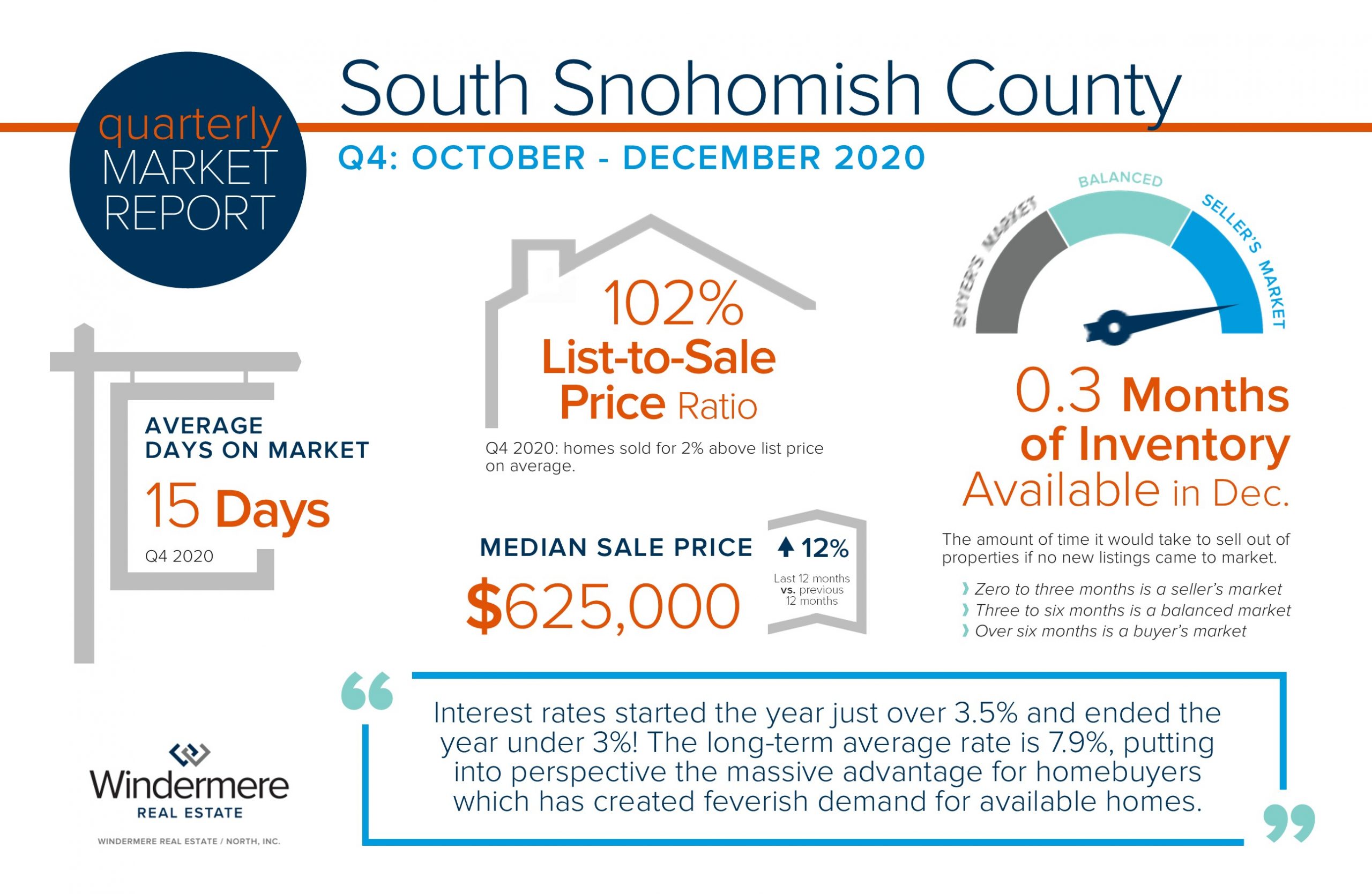
The 2020 real estate market was a bright spot in the economy and the fourth quarter finished strong, with the median price up 12% complete year-over-year. Interest rates started the year just over 3.5% and ended the year under 3%! The long-term average rate is 7.9%, putting into perspective the massive advantage for homebuyers which has created feverish demand for available homes. Even though new listings were down by 6% in 2020, low interest rates helped drive a 3% increase in closed sales.
Pandemic-driven moves were spurred by folks working from home, taking early retirement, and in some cases responding to job loss. Remote working eliminated the need to have a home close to work which encouraged people to flee to the suburbs. Eliminating the commute and the desire for larger spaces with outdoor enjoyment quickly moved to the top of peoples’ wish lists. The last 8 years of positive price growth has led to formidable seller equity, enabling early retirement for some and/or the opportunity to liquidate and recover from the negative effects in some employment industries.
We expect rates to stay low in 2021 and with many Millennials coming of age there will continue to be large amounts of homebuyers eagerly waiting for fresh inventory. Ending the year at 0.3 months of inventory is essentially ground zero for selection, putting home sellers in the driver’s seat for now. I will continue to keep you updated throughout 2021 as we navigate these unique times. It is my goal to help keep my clients informed and empower strong decisions; please reach out if I can help.
2021 Economic Forecast with Matthew Gardner!

PRESENTATION FROM 6:30 – 7:30 PM
Q&A TO FOLLOW
Did you know that home prices in King County are up 8% complete year-over-year and in Snohomish County 11%? Despite the pandemic, home sales in King and Snohomish Counties through Nov 30th, 2020 are both up 5%. While 2020 was a challenging year there was also a lot to be grateful for. I tried my best to stay focused on the silver linings, and the real estate market was certainly one of them!
The New Year is the perfect time to reflect on what has happened, where we are at, and where we are headed. I think this year more than ever this type of reflection and planning will be key for peace of mind and successful pivots. With that said, the special invitation above is not one you will want to miss. My office has commissioned Matthew Gardner, Windermere’s Chief Economist for the 12th year to provide our clients with a thoughtful and well-researched forecast for the local real estate market and the economy overall. He will shore up final statistics for 2020 and look at what the future holds in regards to our country’s and region’s economic stability and the strength of our local housing market.
This year it will be a virtual event via the tool we all got to know well in 2020, Zoom. If you would like to attend, please call, text, or email me by January 13th to be placed on the invitee distribution list. I will send you the link to the event prior to the event on the evening of January 20th. Then, you can snuggle up on your couch and listen to what Matthew predicts we have in store on the economic front. Personally, I am very much looking forward to what he has to share and hope to take it all in “virtually” alongside you.
Below is a sneak peek that includes his national forecast, check out the video below. Let this get you started on your education journey and help prepare you for what he has to share about our region on January 20th. It is always my goal to help keep my clients informed and empower strong decisions, now more than ever.
Video Link:
If you follow me on social media, you might have seen that my office coordinated a food drive just before Christmas, and wow did all of you respond! In just this one fundraiser, we raised over $10k and almost 2,500 pounds of food for our neighbors in need. Amazing! This could not have happened without the support and contributions from our clients and friends.
It was apparent early on that food insecurity was prevalent in our community due to the pandemic. We quickly adapted our community service efforts and made this our office’s focus throughout 2020. Since May, my office did 4 food drives with tremendous responses for each, thanks to you. In total, we collected $23,919 and 5,590 pounds of food for local food banks in 2020. What an outpouring of love and compassion!
Thank you, and Happy New Year!
Inventory, Equity & Experts!

It is important that we pay attention to the data when measuring the health of the housing market. There are a lot of feelings and media influences that can play into one’s opinion of the housing market. I choose to focus on three things: inventory, equity levels, and the experts. This has been and will continue to be my guide in order to be a valuable aid to my clients. To quote Peter Kann, former publisher of the WSJ, “truth is attainable by laying fact upon fact”.
Inventory levels nationally and in our region continue to be historically low. In fact, national inventory levels are at 2.7 months of inventory, and are the lowest they have been since the National Association of Realtors (NAR) started to report them in 1982. There are only approximately 1.2 million single-family homes for sale across the nation. In King County, inventory levels sat at 0.8 months in September and only 0.4 months in Snohomish County. A seller’s market is defined by 0-3 months of inventory, and finding our region with less than one month has us operating in an extreme seller’s market!
The combination of scarce inventory and the lowest interest rates in history has led to above-average price growth year-over-year. Nationally, the single-family median home price is up 15% this September compared to the previous September. In King County, it is up 13%, and in Snohomish County up 14%. It is also important to measure complete year-over-year data. Taking just one month of data and comparing it to the same month a year ago definitely tells a story, but by taking the average of the last 12 months and comparing it to the previous 12 months, you get a more accurate picture of overall growth. It is important to look at both in order to analyze long-term and real-time trends. We must also consider the sustainability of such extreme price growth.
The complete year-over-year price growth percentages temper compared to just looking at the month of September. In King County, the single-family median price is up 5% complete year-over-year and up 8% in Snohomish County. This takes into consideration the stall we saw in the market when the pandemic hit, along with the less extreme inventory environment we started 2020 with. Looking at the data one way gives us the big picture and looking at the most recent data tells the story of what is happening now in comparison to a snapshot one year ago. Pricing is still an art in a seller’s market and even though we are seeing historically low inventory levels, it is certainly possible to over-price and miss the mark for a great outcome.
The multi-family market which includes condominiums is also seeing price growth, but not as strong as single-family. There seems to be a trend with more people working from home and retiring who want to obtain larger interior spaces and room for outdoor enjoyment. The suburbs and smalls towns are gaining a ton of traction with commute-times being lower on the list of considerations. However, the surge of first-time buyers coming into the market due to Millennials coming of age and the historically low interest rates has the multi-family market in growth mode as well.
Nationally, multi-family (which includes condo) inventory sits at four months of inventory, which is a balanced market. In King County, there are two months of available inventory and in Snohomish County 0.7 months. King County’s condo market has seen a larger flood of available inventory, with folks transferring equity to single-family homes in the suburbs and exiting the city. Both counties’ condo markets are still experiencing year-over-year price growth, but due to density in certain areas, price analysis should be studied by the specific building and location. The ability to eliminate commutes by working from home has taken the shine off of condo price affordability as some buyers are opting to purchase a single-family home further out, resulting in a similar monthly payment.
Equity levels across our nation are formidable. 42% of homeowners own their home free-and-clear and 58% of homeowners have 60% equity or more! Unlike the Great Recession of 2008 that was centered on housing, we are experiencing quite the opposite. With unemployment still an important issue, some homeowners will utilize their positive equity position to help relieve financial pressure as they pivot to an alternative career path and/or geographic location. Housing will be a tool for some to navigate the economic uncertainty the pandemic has caused.
The experts I continue to follow are Matthew Gardner, Windermere’s Chief Economist, and David Childers and Steve Harney from Keeping Current Matters. Along with following their well-researched and thoughtful insights I am committed to studying the local monthly, weekly, and daily statistics that represent our local real estate market.
Trends can vary from one neighborhood to the next or from one type of product to another. It is my mission to position myself as an expert in order to serve my clients, by digging deep into the local data, discerning, and reporting back the truth. The strategy of layering fact upon fact is my guide to help develop the most successful outcome possible for my clients.
As always, it is my goal to help keep my clients informed in order to empower strong decisions, especially during these unique times. Please reach out if you need some help, want to satisfy a curiosity, or have a friend in need of some solid real estate guidance. In the meantime, please check out the video below featuring Matthew’s latest update including three recent data points that tell a story about the housing market. Be well!
As the Official Real Estate company of the Seattle Seahawks, Windermere donates $100 to Mary’s Place for every home game Hawks tackle. During last Sunday’s game we raised another $4,200, bringing our total to $140,500.
 Facebook
Facebook
 X
X
 Pinterest
Pinterest
 Copy Link
Copy Link





